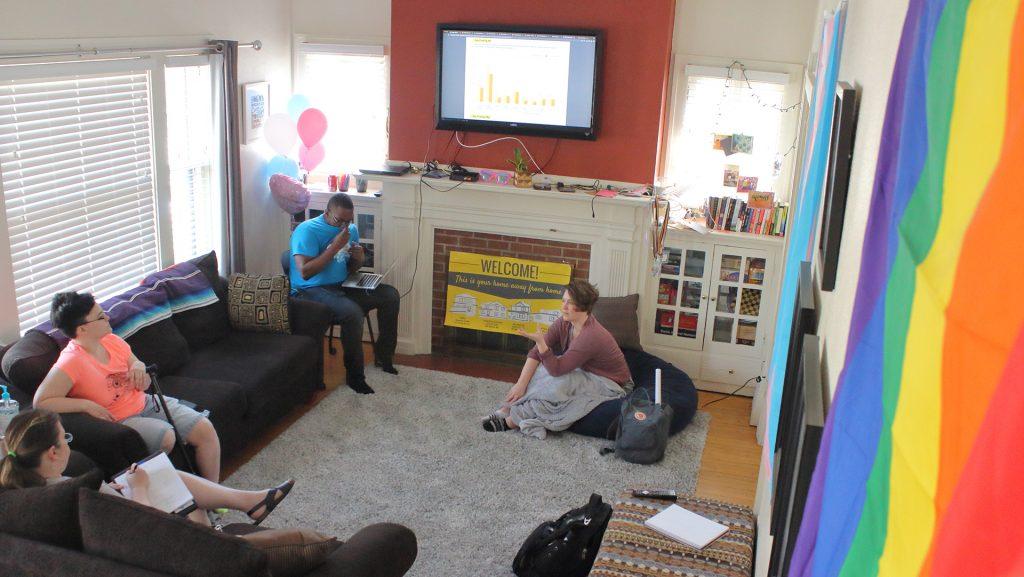UI official: ‘It really hurts my heart’ to see higher rates of sexual violence among LGBTQ students
The Daily Iowan; Photos by Ashle
Students and faculty talk at the LGBTQ Resource Center on Monday, April 30, 2018. They discussed the results of the Speak Out survey conducted on campus. (Ashley Morris/The Daily Iowan)
May 1, 2018
As LGBTQ-identifying students on campus report experiencing higher rates of sexual misconduct and violence, advocates suggest the university community could do more to support its LGBTQ members.
Results from the second iteration of the University of Iowa’s Speak Out Iowa campus-climate survey, released April 26, reveal lesbian, gay, and bisexual students report higher rates of victimization.
Sexual violence occurs at higher rates for LGBTQ students
Associate Professor Carolyn Copps Hartley, the chair of the Sexual Misconduct Climate Survey Subcommittee, said that between the years the UI conducts the campus-wide survey, the group may try to do more focused data collection on key findings.
“For example, students who identify as gay, bisexual, or lesbian, they are at higher risk,” Hartley said. “It would be helpful to understand more about their experiences with victimization.”
RELATED: UI gets improved response in second campus-wide sexual assault survey
The 2017 survey results show 41.9 percent of bisexual women report unwanted sexual contact — a rate about 15 percent higher than lesbian and heterosexual women — with bisexual women also reporting 6.5 percent higher rates of rape.
Gay men also report higher rates of unwanted sexual contact compared to heterosexual men. Rates of rape victimization are also disproportionately higher, with 20.7 percent of gay men reporting having been raped compared to 3.6 percent of heterosexual men.
“It really hurts my heart to see that,” LGBTQ Resource Center coordinator Jennifer Jones said.
Kimberly Andresen-Reed, the executive director of Transformative Healing, an organization working to end sexual violence in the LGBTQ community, said queer survivors experience additional barriers to accessing services and reporting their sexual misconduct.
“There’s also the fear of potentially being outed, there’s the fear of not having receptive services,” she said. “… There’s the additional emotional labor of actually having to explain your identity to somebody. In a way, too, it’s like when we’re working with a queer survivor, it’s not just the trauma that they’ve experienced. It’s also the daily trauma that they experienced, like microaggressions.”
Lack of conclusions drawn from transgender student responses
The survey findings have drawn criticism for failing to draw conclusions about sexual misconduct among transgender students.
Of the 6,952 students who responded, 92 — or 1.3 percent — identified as a gender other than male or female. Data from the UI’s 2018 diversity update show 0.2 percent of undergraduates identified as intersex or did not provide their gender.
Despite being a small portion of the sample, Andresen-Reed said it was arguably representative. A 2016 study from the Williams Institute shows 0.6 percent of adults in the U.S. identify as transgender.
“It’s disappointing to have people respond to the survey and have what looks to be a representative sample and not to use that,” she said. “… You have the numbers, you can run them.”
Because the population was not statistically significant, Copps Hartley said, the UI may look to gather data through other methods, such as focus groups, to gather more qualitative data.
“Even though statistically it was a small population, that doesn’t diminish the fact that they’re University of Iowa students and we need to pay close attention,” Jones said.
Next steps to support the LGBTQ community
Part of the UI’s 2018-2021 Antiviolence Plan addresses ensuring campus prevention, education, and intervention efforts meet the needs of under-represented and historically marginalized communities, including LGBTQ students.
To improve accessibility to services for members of the LGBTQ community, Andresen-Reed said she is working with the UI and the Rape Victim Advocacy Program to make herself more accessible to queer survivors on campus through office hours.
RELATED: University of Iowa response to sexual misconduct continues to evolve after second Speak Out Iowa survey
Jones said next semester, one of her focuses on programming at the resource center will be to help survivors of violence understand the dynamics of healthy relationships and the power structures that are unique within LGBTQ relationships.
Still, there remains a gap between heterosexual and LGBTQ individuals that Jones said she would like to see the university better address.
“… I think that there needs to be more of an effort university-wide — not just through multicultural programs or the Division of Student Life — but university-wide to have an understanding of what good allyship means, but also that sexual violence is not just for hetero individuals,” Jones said. “This is something that is pervasive throughout every community.”



